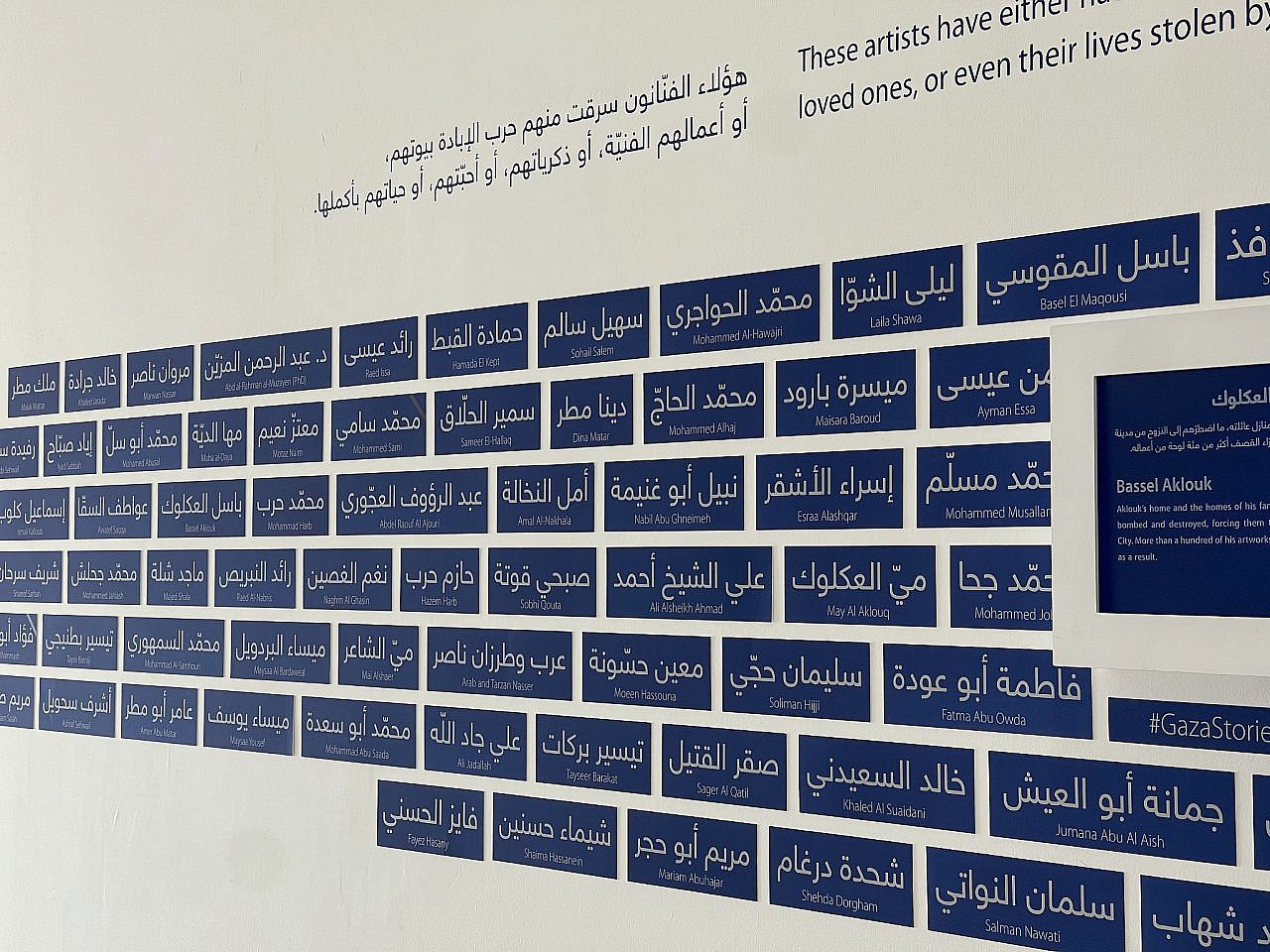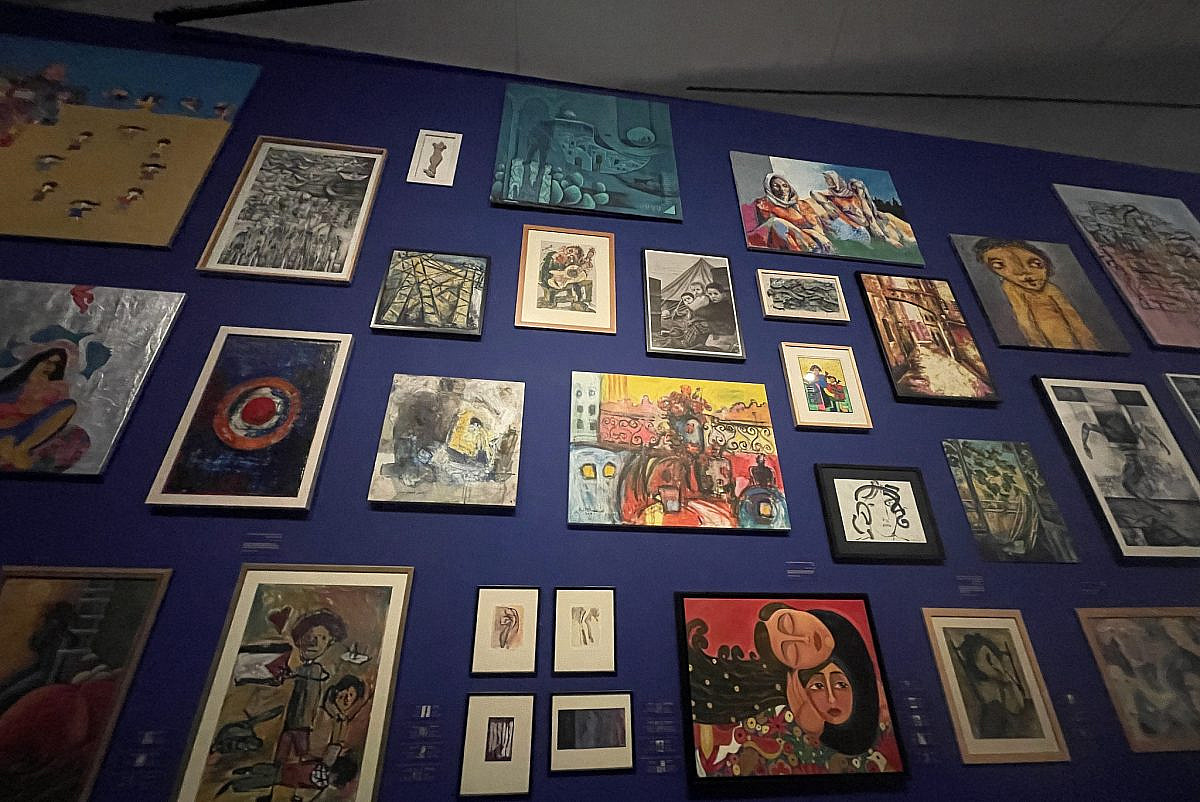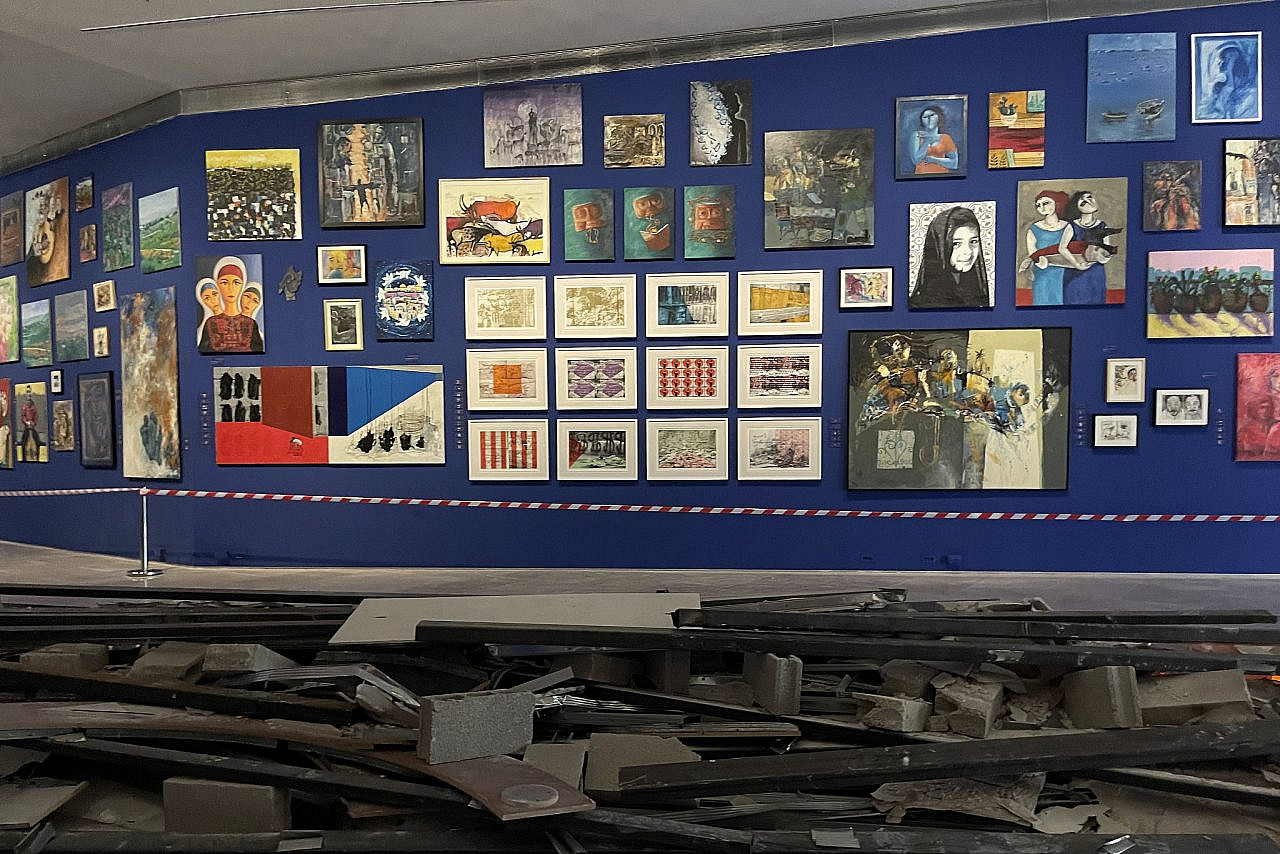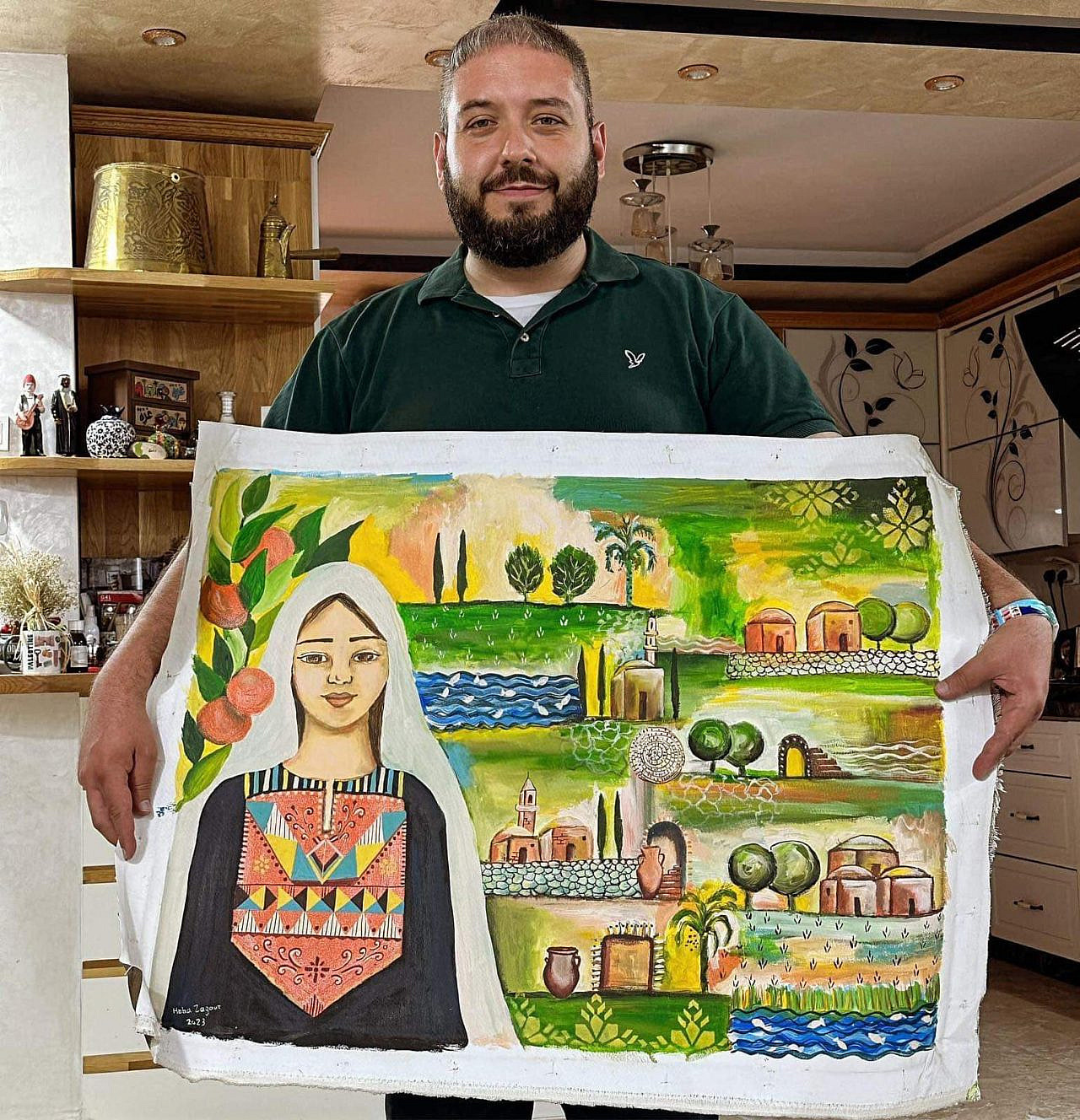In a large hall, dim lighting casts long shadows over a pile of rubble, while the incessant buzzing of drones echoes all around. Such is the somber greeting for visitors entering an exhibition currently on display at the Palestinian Museum, in the occupied West Bank town of Birzeit.
“This is Not an Exhibition,” which runs until August, showcases some 300 artworks by Gazan artists. Walking around the hall is something of a sensory overload, pulling visitors between visual and auditory stimuli. Paintings crowd around each other in no particular order on the museum’s darkened indigo walls, evoking the chaos of the ravaged Palestinian art scene in Gaza.
The art pieces, collated since December from galleries, institutions, and collectors across Palestine, are a testament to Gaza’s cultural production in its darkest hour. Some of the artists have been killed in recent months by Israel’s bombardment. A few managed to escape the besieged Strip. Most of them are currently displaced within it.
The exhibition is an attempt both to capture and counteract what the organizers describe as the “erasure” of Palestinian life and culture in Gaza. This includes the destruction of the Strip’s two contemporary art galleries: Eltiqa, in downtown Gaza City, was destroyed in an Israeli airstrike in December, while Shababeek, which was housed in an old building close to Al-Shifa Hospital, was reduced to rubble when the Israeli military laid siege to the hospital complex and much of its surrounding area in March. Artists from both galleries, almost all of whom have been displaced due to the war, were granted space in the Palestinian Museum to showcase their work.
“The entire art scene, its people, productions, and spaces, have been profoundly impacted by the devastation of war,” lamented Sharif Sarhan, the director of Shababeek, who spoke to +972 from Paris where he was staying before the war broke out and has since remained. The majority of art still inside Gaza has either been destroyed or damaged by Israeli attacks, or looted by residents in a desperate search for materials to burn for fire. “You could be looking at the last surviving works produced by Gaza’s artists,” Sarhan added.
Some of the pieces were created using unconventional materials. One oil painting portrays the rubble of a home; on closer inspection, the canvas — which can be hard to come by in Gaza — is the same thick white cloth used for burial shrouds.
The effect of the exhibition on the visitor is immersive and almost dizzying. “It leaves a lasting impression, blurring the boundaries between different artistic expressions and inviting deeper engagement with the artworks,” Suhad Awad, a historian visiting the museum in early May, told +972 Magazine. “It makes me feel like I’m in Gaza.”
‘There wouldn’t be a next time’
The last artwork in the exhibition to have escaped Gaza was procured just days before the war began. On Oct. 3, Chris Whitman, a humanitarian worker who lives in Kufr Aqab, on the outskirts of Jerusalem, left the Strip with a piece he had long had his eye on.
“In the summer of 2021, I stumbled upon a treasure: my first piece by the talented Heba Zagout,” Whitman reminisced. Titled “Jenin,” the painting depicts a sabr cactus next to a cluster of houses at sunset, which Zagout had completed earlier that year. “I could still feel the excitement of that encounter and the conversation we had about the hurdles of bringing quality canvas and paint into Gaza.” With each subsequent deployment to the besieged Strip, Whitman’s bond with Zagout’s art deepened.
From among her creations, a piece called “Asdood” stood out — the Arabic name for what is today the Israeli city of Ashdod. It portrays several scenes of life in the city before the Nakba of 1948, when hundreds of Palestinian families, including Zagout’s, were expelled from the area. The painting blends together stories of Asdood that Zagout heard from her grandmother with her own artistic visions, as she was never able to visit the city. On one side, Zagout herself can be seen walking toward the sea.
Although the painting caught Whitman’s eye in February of last year, he could not afford it. “In June, Hiba graciously offered me a discount and held the painting for me in anticipation of my return to Gaza,” he explained.
On Oct. 3, Whitman went to the elementary school where Zagout taught and managed to speak to her for 15 minutes during a break between classes. When Zagout unrolled the painting, Whitman fell in love with it all over again and took it with him out of Gaza later that day. They did not manage to snap a selfie, said Whitman, because Zagout wanted to rush back to her students. “She said next time, but there wouldn’t be a next time.”
Four days later, Hamas attacked southern Israel, and the Israeli onslaught that has devastated so much of Gaza and its artistic community began. On Oct. 13, just 10 days after seeing Whitman, Zagout was killed in an airstrike on her house in Al-Bureij refugee camp, in central Gaza. She was 39 years old. Two of her children were killed alongside her, and most of her paintings were destroyed in the house.
Maysa, Zagout’s sister, told +972 that the artist’s two youngest sons — Adam, 10, and Mahmoud, 6 — were pulled lifeless from under the rubble of their home. Zagout herself is still there: her head and hands were detached from her body, Maysa explained, but “we were not able to get her whole body from under the rubble yet to bury her.”

A living project
Only four of Zagout’s paintings and her scrapbook survived the airstrike, though all of them were damaged by rubble, dust, shrapnel, and bloodstains, Maysa explained. “Hiba lived and died in Al-Bureij. She was a happy person, despite her hard life. She would rest a bit after her work at school, then go to her painting stand and draw, almost daily, before posting her works online to find a buyer.”
The two paintings that Whitman procured for his home, each depicting a different Palestinian city, are the only remaining unblemished testaments to Zagout’s life and work. They now hang on the indigo wall of Birzeit’s Palestinian Museum alongside scores of other works that survived the devastation of Gaza’s art scene.
Most read on +972
Five other artists whose work is displayed in the exhibition were also killed in Israel’s ongoing assault on the Strip. Yet despite this backdrop of death and ruin, the exhibition remains a living project. The number of pieces on display has surpassed 300, with more expected to arrive soon from various institutions and collectors — even without the museum issuing an open call. Some of them are undated because communications blackouts have prevented the curators from contacting the artists.
“This is Not an Exhibition” thus serves as a reminder of the vital role of art in preserving memory and bearing witness to history. Although it has been curtailed within just a few dozen square kilometers for nearly two decades, Gaza’s artistic community — particularly in Gaza City — has been remarkably prolific. The exhibition immortalizes this legacy and could be seen, at least for those artists who survive the war, as an illumination of its future.







